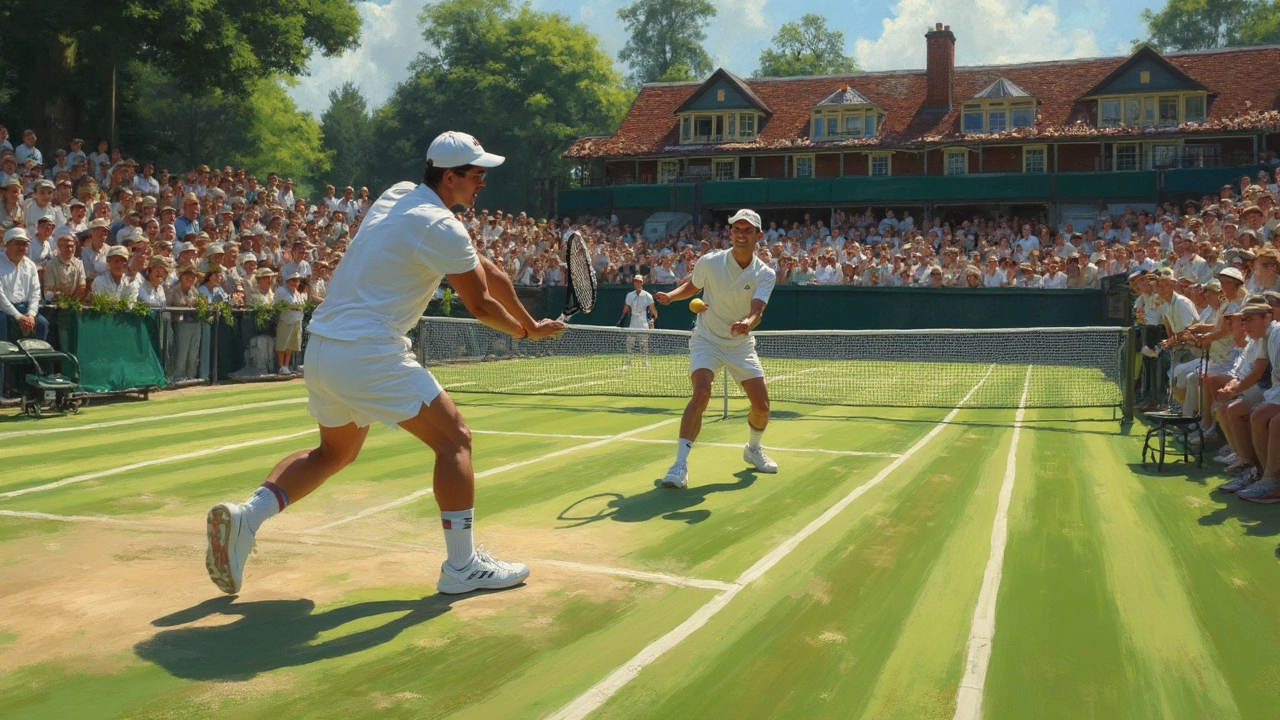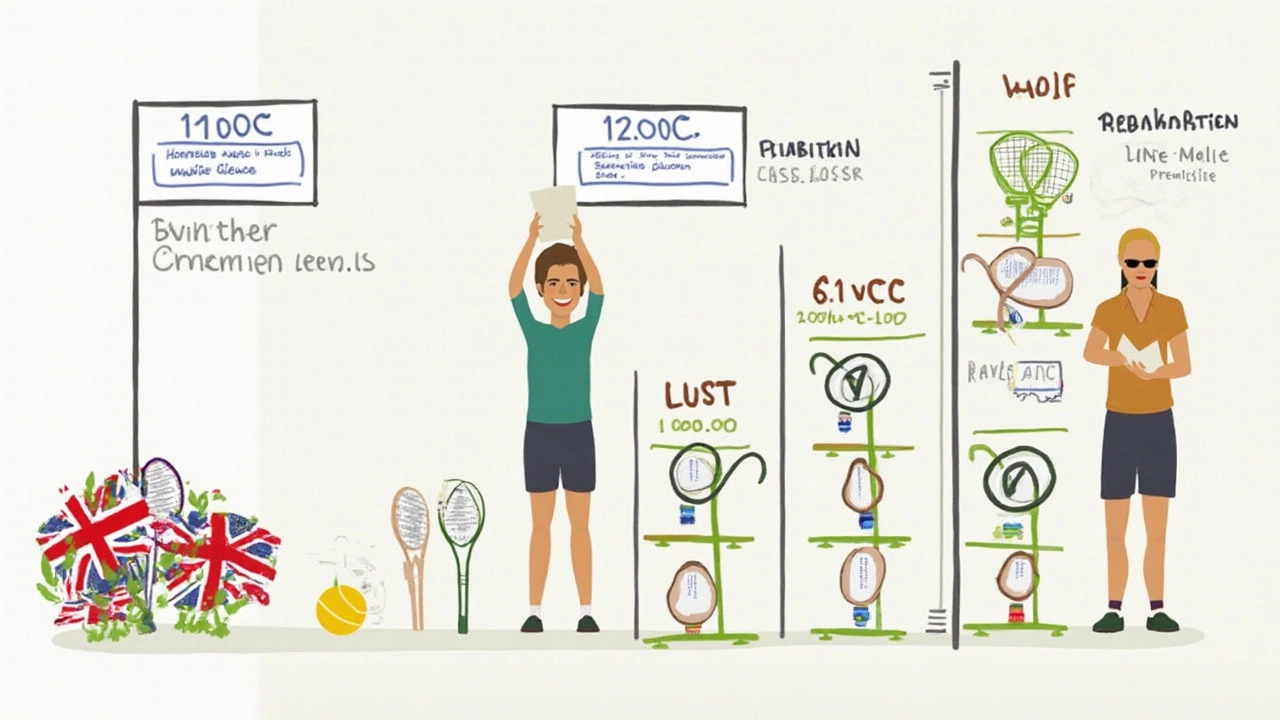8.0 Ranking in Tennis: What Does It Really Mean?

Ever heard someone claim they're an "8.0" tennis player? It sounds fancy, but what does it actually mean? If you hang around tennis clubs or browse tournament signups, you'll see rankings tossed around all the time. Some are chatting about 4.0s and 5.5s. Others are dropping 8.0 like it's some sort of secret handshake. If you want to play tournaments or just keep up with tennis friends, it's worth knowing how this ranking works.
Here's the basic gist: tennis uses a number-based rating system to sort players. This helps make sure matches are fair, putting players with similar skill levels against each other. Knowing where you stand makes a huge difference if you're aiming to jump into local leagues or dream of going pro. An 8.0 ranking isn't something you just stumble on—it's rare air, almost mythic in the amateur world. But before you start daydreaming about Wimbledon, let's break down where that number fits and why it matters.
- Decoding the Tennis Ranking System
- What Exactly Is an 8.0 Ranking?
- Who Competes at 8.0 Level?
- How to Improve Your Tennis Ranking
- 8.0 Ranking Myths and Surprising Facts
Decoding the Tennis Ranking System
If you want to understand what “8.0” means in tennis, you’ve got to start with the rating systems. In the U.S., most adults go by the National Tennis Rating Program (NTRP)—a scale that runs from beginner (1.0) all the way up to 7.0 and sometimes higher. You’ll also see rating systems in other countries, but NTRP is king in local leagues and tournaments around the States.
The NTRP isn’t just for tournament officials—it’s for anyone who wants to find a match that isn’t going to end in total frustration or boredom. Here’s a quick table to show how the ratings break down:
| NTRP Level | Skill Description |
|---|---|
| 1.0-2.0 | New to tennis or still learning the basics |
| 2.5-3.0 | Can rally a bit, starting to play matches |
| 3.5-4.0 | Plays regularly, knows tactics, has some power |
| 4.5-5.0 | Advanced, plays with control and variety |
| 5.5-6.0 | Highly skilled, plays in national tournaments |
| 6.5-7.0+ | Full-time pros, competing internationally |
So where does this so-called 8.0 tennis ranking fit? Actually, 8.0 shows up mostly in team leagues, like combined doubles in USTA leagues, where each player’s rating is added together for the team’s total. Individually, 7.0 is about the top, reserved for folks who make a living playing or coaching at the highest levels.
If you ever sign up for a league, they'll ask you for your NTRP level or help you figure it out. If you fudge it, you'll get caught—and probably moved after your first few matches anyway. The whole point: make matches fun and fair. NTRP is updated every year based on your results, so things can change if you’re on a winning (or losing) streak.
While some local systems use numbers like 8.0 for teams, the highest solo player rating NTRP officially gives anyone is 7.0. If you hear someone say they’re a singles 8.0 player—either they’ve got a wild sense of humor, or they’re talking about a team rating. Keep that in mind before you let them scare you off the court!
What Exactly Is an 8.0 Ranking?
Alright, let's get real about this: the 8.0 ranking sits basically at the top of the tennis rating ladder in the U.S. If you've ever checked out the NTRP (National Tennis Rating Program) system, you'll notice that most regular players fall between 2.5 and 5.5. Going up the ranks, you'll spot 6.0 and 7.0, usually reserved for super competitive tournament players. But 8.0? That's another world—it's for folks playing at the very highest, almost professional level.
The most important thing you need to know? The 8.0 tennis rating is generally used for team events like World TeamTennis and USTA Combo Leagues where two players’ ratings add up, like pairing a 4.0 and another 4.0 to make an “8.0 team.” So, when people mention playing in “8.0 tennis,” they usually mean their team’s combined rating, not a single person's skill.
Here’s how it breaks down compared to the rest of the system:
| NTRP Level | Player Type |
|---|---|
| 2.5 - 4.0 | Recreation to intermediate club player |
| 4.5 - 5.5 | Advanced club and regional tournament players |
| 6.0 - 7.0 | College, semi-pro, former low-ranked pros |
| 8.0+ | Top pros, world-class players, or teams with two high-level players |
In singles, hardly anyone holds an 8.0. If they do, they’re at the level of folks you see in Grand Slam tournaments. In club or league play, though, most 8.0-rated matches mean a combined doubles team, not an individual.
If you're thinking of signing up for tournaments labeled “8.0,” check the fine print. They usually want your team’s two ratings to add up to 8.0 or less. That means a 4.5 and a 3.5 can play together, or two 4.0s.
- If someone claims to be an 8.0 tennis player, they’re probably talking about their spot on a team, not their actual solo rating.
- The system keeps things fun and fair, so you don’t end up facing a former pro if you’re a weekend warrior.
So, the next time you see “8.0” on a league board, you’ll know that it’s less about superhero-level tennis skills and more about building balanced, competitive teams.

Who Competes at 8.0 Level?
If you're seeing someone with an 8.0 tennis rating, you're looking at a unicorn. Seriously, almost nobody in your local league—probably not even your club pro—has this on their profile. The tennis ranking system, especially in the U.S., usually tops out around 7.0 for the National Tennis Rating Program (NTRP). And that 7.0? That’s for ATP or WTA professional players, basically the folks you see smashing serves on live TV. So, if someone says they're an 8.0, they're joking—or maybe they’re Novak Djokovic on a good day.
Why even mention 8.0? Sometimes tournament organizers use combo rankings for doubles or mixed doubles. For example, an “8.0 doubles” event means the combined rating of both players must add up to 8.0—like a 4.0 and a 4.0 together. But as a level by itself, 8.0 signals an ultra-elite (and almost imaginary) status, well above top-level pro.
Here's a quick look at how NTRP levels compare to different types of players:
| NTRP Level | Who Plays Here |
|---|---|
| 2.0 - 3.0 | Beginners and casual club players |
| 4.0 - 5.0 | Advanced club players, good regional competitors |
| 6.0 - 7.0 | Nationally ranked amateurs, pro players |
| 8.0 | Above pro level (not an official singles player rating) |
So, who competes at an 8.0 ranking in singles? Pretty much nobody; it’s more a technical ceiling. In doubles events, though, you might register for an “8.0” division based on combining two partners’ scores. If you’re hunting for the world’s best, stick to Grand Slams—those legends are as close to "8.0" as humans can get.
How to Improve Your Tennis Ranking
If you want to climb the ranks and even dream about that 8.0 status, there’s no shortcut. Consistency, smart practice, and playing the right matches can get you there. Let’s walk through some clear steps and facts that actually move the needle on your tennis ranking.
- Play More Matches: NTRP and UTR rankings (used in the U.S. and worldwide) both reward match wins—especially against higher-ranked opponents. If you rarely compete, your rating just won’t budge.
- Mix Up Your Opponents: Regularly challenge players who are ranked higher than you, not just your comfort zone hitting partners. This pushes your skills and gives you a chance to score "big wins" that count more for your rating.
- Focus on Weaknesses: Honest self-checks matter. Find one thing that breaks down under pressure, like your backhand or second serve, and hammer it out in practice before each league season.
- Track Stats: Tennis isn’t just about hitting pretty shots. Track your actual win-loss ratio, first serve percentage, and unforced errors each match. Even some pros find key jumps in their ranking come after really focusing on match stats.
- Get Tournament Experience: You need a blend of singles and doubles under your belt. Some tournaments—especially USTA-sanctioned ones—carry more weight for your rating, so pick those over just casual club ladders.
| Tennis Level | Estimated Win Rate Needed for Next Rank | Avg. Weekly Practice (hours) |
|---|---|---|
| 4.0 | ~70% vs. lower levels | 4-6 |
| 5.0 | ~60% vs. same level | 6-8 |
| 6.0+ | Win vs. higher-rated | 8+ |
Don’t get stuck just watching instructional videos. Find a local coach, even just monthly—it’s proven that players who take private or group lessons see improvement up to 30% quicker than solo players.
Last tip? Stay hungry but not frustrated. Ranking jumps especially from 6.0 onward can take years. Even top juniors sometimes stall for a whole season. Everyone has dry spells and those weird matches where you just can’t hit a forehand. Learn from each one, shake it off, and keep showing up.

8.0 Ranking Myths and Surprising Facts
First things first: hardly anyone outside of the actual tennis pros ever reaches an 8.0 ranking. It's not just a solid score—it's the tip-top, reserved for those who play at the absolute highest level. If you see an 8.0 on someone’s profile in your local league, check twice. It could be a mistake, or they might actually have played on the ATP, WTA, or Davis Cup circuits. In the tennis ranking world, an 8.0 is almost like having unicorn status.
One big myth is people often think the USTA NTRP scale tops out at 7.0, not realizing the rare 8.0 exists for those in world-class pro leagues. In day-to-day USTA events, 7.0 is usually the cut-off. The 8.0 rank is mostly for record-keeping and bigger tournaments where actual pros show up. So, if you’re aiming for that spot, get ready for some seriously tough company.
A lot of folks also assume you can "test" your way to an 8.0 by acing drills or clinics. That’s not how it goes. The only real way to get an 8.0 is competing and winning at the highest professional level. No country club hitting partner or online test is giving you that badge.
Check out this quick comparison to put it all in perspective:
| NTRP Level | Category | Typical Player Description |
|---|---|---|
| 3.0 | Recreational | Can hit the ball over, some consistency |
| 4.5 | Competitive Amateur | Regular club player, strong skills |
| 6.0 | Collegiate/National | D1 college player, elite amateurs |
| 7.0 | Professional | Has ATP or WTA points |
| 8.0 | World-class Pro | Top-ranked or major international competitor |
Here's another quirky fact: Some tennis tournaments slap "8.0" on doubles events, but that often means the combined NTRP rating of both players (for example, two 4.0 players). Don’t get that mixed up with the single-player 8.0 rank. It's easy to confuse, and a lot of folks do!
If you’re motivated by stats, consider this: only about 1 out of 10,000 competitive adult players reaches an NTRP 7.0 or above, and almost all are full-time professionals. That’s even fewer than the odds of getting struck by lightning in your life. Crazy, right?
The bottom line? If you hear someone talking 8.0, check if they're joking—or signing autographs. For the rest of us, there’s a satisfying journey at every level below it, with plenty of tough matches and bragging rights to be earned along the way.
